Thermal imaging keeps passengers on the move during cold snap

Network Rail is using pioneering technology to keep passengers on the move during this week’s spell of extremely cold weather by using thermal imaging drones.
The drones, which are now used routinely on the West Coast main line in Cumbria, help engineers remotely inspect the line and deploy resources to where we need it most.
The West Coast Main line has a series of heated points to prevent them from freezing over in extremely cold conditions. By inspecting with drones, engineers can quickly and easily see if there have been problems.
With temperatures predicted to drop as low as -6 in parts of Cumbria tonight, this is a vital tool for engineers.
Travel disruption is possible all week due to the extreme low temperatures, with snow, ice and freezing rain predicted until Friday night, temperatures begin to rise on Saturday.
This could impact rail travel on some rural routes in the Peak District, between Manchester and Leeds and in Cumbria.
The Merseyside area is receiving specialist anti-ice treatment on the Merseyrail network to reduce issues the cold weather could cause to powering the fleet of trains.
Passengers are being urged to check www.nationalrail.co.uk to see if their train is running before they set off from home.
Chris Pye, Network Rail’s North West route infrastructure director said: "We use this technology to ensure that points, which we use to direct trains on the track, don’t become compacted with snow and ice. Our teams monitor these remotely and we have further teams on standby ready to respond should it be needed.
“Snow and ice always pose a challenge at this time of the year, not only to the track, it can also obscure signals and causes branches to fall from trees on to the line."
